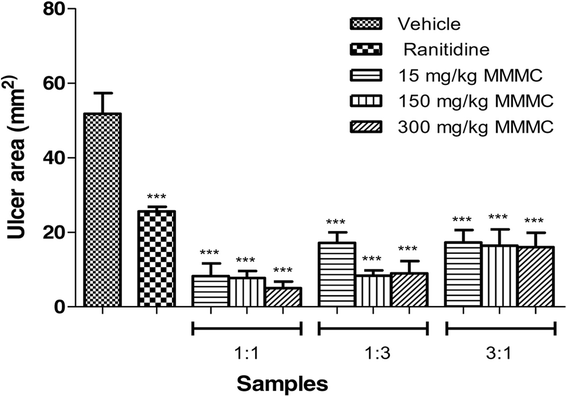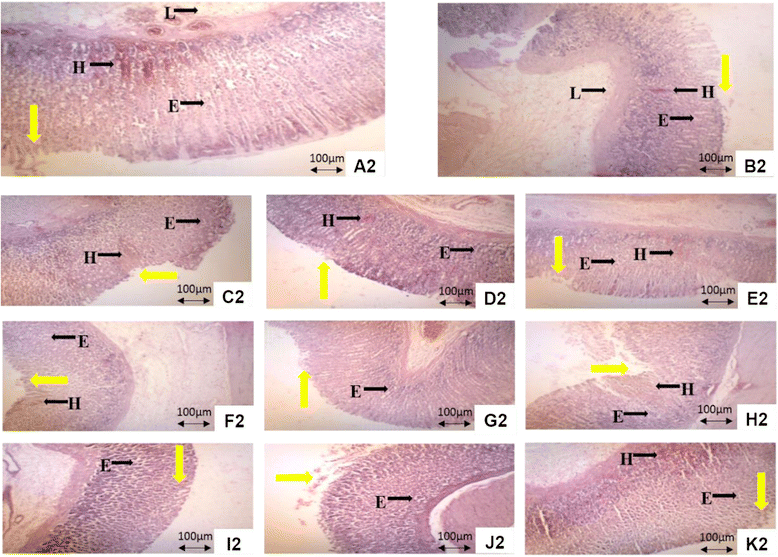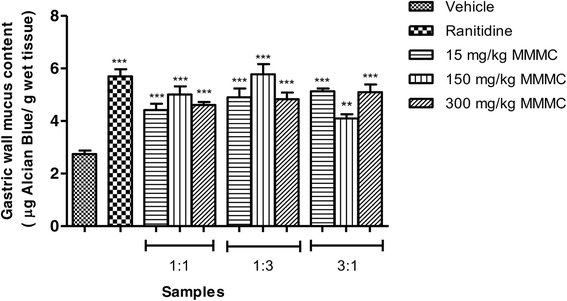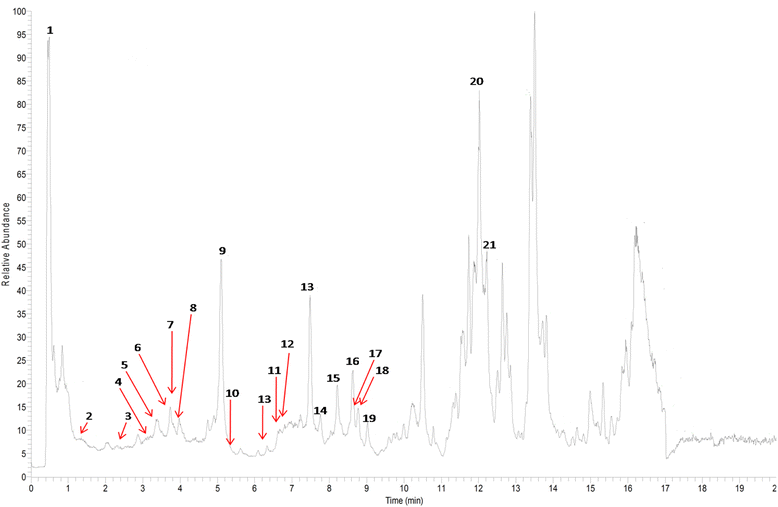Synergistic gastroprotective activity of methanolic extract of a mixture of Melastoma malabathricum and Muntingia calabura leaves in rats
- PMID: 29121900
- PMCID: PMC5679158
- DOI: 10.1186/s12906-017-1992-9
Synergistic gastroprotective activity of methanolic extract of a mixture of Melastoma malabathricum and Muntingia calabura leaves in rats
Abstract
Background: Melastoma malabathricum L. (family Melastomaceae; MM) and Muntingia calabura L. (family Elaeocarpaceae; MC) have been separately reported to possess gastroprotective activity. In an attempt to develop a pharmaceutical product with antiulcer potential, the synergistic gastroprotective activity of methanolic extract of a mixture of MM and MC (MMMC) at various ratios was evaluated in rat models.
Methods: Rats were pre-treated orally with 2% Tween 80 (vehicle), 100 mg/kg ranitidine (reference drug) or MMMC (ratios of 1:1, 1:3 and 3:1 (v/v); doses of 15, 150 or 300 mg/kg) and then subjected to the ethanol-induced gastric ulcer or pyloric ligation assays. Stomach of rats from the former assay was collected and subjected to the macroscopic and microscopic observations, and enzymatic and non-enzymatic antioxidant studies while the gastric juice content and tissue from the latter assay were subjected to the antisecretory activity study. The UHPLC analysis of MMMC was also performed.
Result: MMMC, in the ratio 1:1, demonstrated the most effective (P < 0.001) gastroprotective activity indicated by the highest reduction in ethanol-induced ulcer area formation. These macroscopic findings were supported by the microscopic observations. Except for pH and total acidity, MMMC also significantly (P < 0.001) reduced the volume of gastric content but increased the gastric wall mucus content in the pyloric-ligation test. MMMC also demonstrated remarkable antioxidant activity indicated by the highest total phenolic content (TPC) value and oxygen radical absorbance capacity (ORAC) activity with the recorded IC50 value of approximately 53 μg/mL for the 2,2- diphenyl-1-picrylhydrazyl (DPPH) scavenging activity. MMMC also improved the catalase (CAT), superoxide dismutase (SOD), glutathione (GSH), prostaglandin E2 (PGE2) and malondialdehyde (MDA) activities of the gastric tissue intoxicated by ethanol. UHPLC analysis of MMMC confirmed the presence several flavonoid-based bioactive compounds.
Conclusion: MMMC, at the ratio of 1:1 (v/v), exerts gastroprotective activity partly by activating its antisecretory and antioxidant activities, and via modulation of the gastric tissue endogenous antioxidant system.
Keywords: Antioxidant; Antisecretory; Gastric ulcer; Melastoma malabathricum; Muntingia calabura; Synergistic effect.
Conflict of interest statement
Ethics approval
The study protocol involving the use of animals in the present study was approved by the Animal Care and Use Committee (ACUC), Faculty of Medicine and Health Sciences, UPM (Ethical approval no: UPM/IACUC/AUP-R010/2015).
Consent for publication
Not applicable.
Competing interests
The authors declare that they have no competing interests.
Publisher’s Note
Springer Nature remains neutral with regard to jurisdictional claims in published maps and institutional affiliations.
Figures






Similar articles
-
Antioxidant and anti-inflammatory activities contribute to the prophylactic effect of semi-purified fractions obtained from the crude methanol extract of Muntingia calabura leaves against gastric ulceration in rats.J Ethnopharmacol. 2015 Apr 22;164:1-15. doi: 10.1016/j.jep.2014.12.017. Epub 2014 Dec 23. J Ethnopharmacol. 2015. PMID: 25540923
-
Gastroprotective activity of chloroform extract of Muntingia calabura and Melastoma malabathricum leaves.Pharm Biol. 2016;54(5):812-26. doi: 10.3109/13880209.2015.1085580. Epub 2015 Oct 9. Pharm Biol. 2016. PMID: 26452435
-
Mechanism(s) of action involved in the gastroprotective activity of Muntingia calabura.J Ethnopharmacol. 2014 Feb 12;151(3):1184-1193. doi: 10.1016/j.jep.2013.12.045. Epub 2013 Dec 28. J Ethnopharmacol. 2014. PMID: 24380736
-
Spices, herbal xenobiotics and the stomach: friends or foes?World J Gastroenterol. 2010 Jun 14;16(22):2710-9. doi: 10.3748/wjg.v16.i22.2710. World J Gastroenterol. 2010. PMID: 20533590 Free PMC article. Review.
-
Antiulcer Effect of Honey in Nonsteroidal Anti-Inflammatory Drugs Induced Gastric Ulcer Model in Rats: A Systematic Review.Evid Based Complement Alternat Med. 2018 Jul 15;2018:7515692. doi: 10.1155/2018/7515692. eCollection 2018. Evid Based Complement Alternat Med. 2018. PMID: 30105063 Free PMC article. Review.
Cited by
-
Purification, Partial Characterization, and Evaluation of the Antiulcer Activity of Calotropis procera Leaf Lectin.Protein Pept Lett. 2022;29(9):775-787. doi: 10.2174/0929866529666220803162457. Protein Pept Lett. 2022. PMID: 35927810 Free PMC article.
-
Protective effect of Pu-erh tea extracts against ethanol-induced gastric mucosal damage in rats.Biomed Rep. 2018 Apr;8(4):335-342. doi: 10.3892/br.2018.1068. Epub 2018 Feb 20. Biomed Rep. 2018. PMID: 29556381 Free PMC article.
-
Gastroprotective effects of Pikad Tri-phol-sa-mut-than herbal remedy on multiple gastric ulcer models in rats.Heliyon. 2023 Aug 19;9(8):e19297. doi: 10.1016/j.heliyon.2023.e19297. eCollection 2023 Aug. Heliyon. 2023. PMID: 37654455 Free PMC article.
-
Antimicrobial Activity of Brassica rapa L. Flowers Extract on Gastrointestinal Tract Infections and Antiulcer Potential Against Indomethacin-Induced Gastric Ulcer in Rats Supported by Metabolomics Profiling.J Inflamm Res. 2021 Dec 29;14:7411-7430. doi: 10.2147/JIR.S345780. eCollection 2021. J Inflamm Res. 2021. PMID: 35002276 Free PMC article.
References
-
- Rang HP, Dale MM, Ritter JM, Flower RJ, Henderson G. Rang and Dale’s pharmacology. 7. Edinburgh: Elsevier Churchill Livingstone; 2012.
MeSH terms
Substances
Grants and funding
LinkOut - more resources
Full Text Sources
Other Literature Sources
Medical
Miscellaneous

